Previously published in: VANAMĀLĀ Festschrift A.J. Gail - serta adalberto joanni gail LXV. diem natalem celebranti ab amicis collegis discipulis dedicata. Eds. Gerd J.R. Mevissen & Klaus Bruhn. Berlin: Weidler Buchverlag, 2006, pp. 28-36.
11
Further Observations on Western Indian Miniatures
Considering the limited number of Jainas through the ages, the amount of Jaina literature is unusual; it defies all attempts at exhaustive investigation. Furthermore, the sheer number of manuscripts is enormous. Finally, many works have given rise to illuminated manuscripts, some to a considerable number of such manuscripts. There is much repetition in the field of book illustration, but repetition is combined with variation, and variation has many faces.
Minute differences between miniatures deserve as much attention as obvious differences. Roughly speaking, most miniatures have been identified by now, but at this stage there is a particular need for accurate analysis as the second step after identification. It is hoped that the present study will give an idea of this situation.
The material on which the present paper is based is identical with the material of our Uttarādhyayana study (2005).[1] However, the labels on the relevant slides (always “Utt...”) are confusing. The situation is described below:
The thirteen slides from Muni Punyavijaya's collection (BRUHN 2005: 38-39) are, according to the labels, all Uttarādhyayana slides. In the case of the six slides published in BRUHN 2005 this is correct for figs. 3-6 (Bild 3-6), but figs. 1-2 (Bild 1-2) may be Uttarādhyayana Sūtra or Kalpasūtra (“general motifs”). The seven slides of the present article have Plate 7 definitely from Kalpasūtra, Plate 6 definitely from Uttarādhyayana Sūtra, Plates 1-2 and 3-4 from Uttarādhyayana Sūtra or from Kalpasūtra (“general motifs”). Plate 5 is also uncertain. - Refer for Utt in general to BRUHN 2005: 38-39.
The thirteen miniatures with their warm colour and careful delineation of motifs are among the best specimens of 15th century painting. The sharp (and crude) contrast between different colours (cf. MORGENROTH/HICKMANN 1979) is absent. All specialists know that 15th century paintings are of uneven quality.
There arises the question whether our thirteen miniatures “belong together” from the point of view of style. However, nothing can justifiably be said as long as we do not have more material. At this stage the manuscripts and the miniatures seem to form some sort of group.
Out of the ten pictures illustrated in the present paper, three belong to “section” I, four to “section” II, and three to “sections” III to V.
SECTION I
The first two pictures (Plates 11.1 and 11.2) show the seated Jina or Tīrthaṃkara (BRUHN 2004: fig. 3; BRUHN 2005: fig. 1). In Western Indian miniature painting, the Jina is usually seated. Here we have, moreover, the case of 15th century Jina pictures with their stereotyped program and their horror vacui (see below). Earlier renderings show greater economy. The Jina NAWAB 1980 (pl. 25 [opp. p. 48]: fig. 96, palm-leaf) has the following formula (from top to bottom):
elephant... elephant,
cāmara-bearer... cāmara-bearer,
small human figure... small human figure,throne-cushion,
throne (deer/cakra/deer).Still simpler is BROWN 1933 (pl. 1 [opp. p. 116]: fig. 1, palm-leaf):
cāmara-bearer... cāmara-bearer,
cushion,
throne (elephant/lion/cakra/lion/elephant).
This Jina wears no jewellery. We show a third early painting which is dated: 11.fig.1, palm-leaf, 1295 A.D. The toraṇa area is crammed with drawings (elephants etc., cf. NAWAB 1956: fig. 60 et passim).
Our first colour plate (11.1) shows the throne or plinth formula elephant/ornament/elephant.
A very clear “double-leaf” is presented, a motif or formula which is derived from sculptural originals (BRUHN 1969: figs. 31, 141 etc.). In miniature painting, the motif consists of two stalks and two buds (with occasional deviations). - Plate 2 has the plinth formula:
elephant (fore-pt.)/stylized cakra/elephant (fore-pt.).There is no “double-leaf”; instead we have two half-views of a pūrṇakalaśa, one half-view to the left of the head of the Jina and one to the right. The dhotī of Plate 2 has, against Plate 1, apparently no “folds” (see SECTION V).
The lower zone of the picture offers but a limited opportunity for variation. The throne is sometimes clear, sometimes blurred. In the “present genre” (seated Jinas of the 15th century) variation does exist, but it is carried out at random, and it is not linked with substantial changes. The dominant impression is repetition. The present genre: NAWAB 1956: col.figs. 1, 60, figs. 72, 156, 186, 238, 274, 276, col.figs. 406, 420, 423, 424.
Plates 1-2 follow the tradition in general and in the following details: There is a mark on the forehead (tilaka) and an object above the hands of the seated Jina (obviously a fruit). The cihna or distinguishing mark is visible directly below the Jina, but often indistinct (Plate 1 quadruped [?]; Plate 2 lion [?]). The Jina is decorated with jewellery, which became standard at an early date.
SECTION II
The following two pictures (Plates 11.3 and 11.4) show possibly Gautama Indrabhūti. But we are in the miniatures strictly speaking not concerned with an individual, but with a type: mainly eleven Gaṇadharas or Fathers-of-the-Church. The Gaṇadhara is in our miniatures a single seated monk shown en face. We occasionally find pictures of the Gaṇadharas (JACOBI 1884: 286-287) with the Gaṇadhara type appearing eleven times (BROWN 1934: figs. 130-132). We also have Gaṇadhara pictures with the names of saints inscribed (SHAH 1978: pl. 6, figs. 17-18), another instance of oscillation between type and individual. Gautama Indrabhūti is according to legend one of the eleven Gaṇadharas (JACOBI 1884: 265-266, 267).
The rosary is the main attribute (hand attribute) of the Gaṇadhara, not compulsory, but frequent. The mudrā is mostly “forefinger touching the thumb, with and without rosary”. The other attributes:
(a) lotus fully developed and rising as a plant from the ground (below the Gaṇadhara), and
(b) lotus as nimbus (mostly stylized). Plate 3: plant, Plate 4: nimbus.The two lotus-motifs are fully developed in 11.fig.3 (1411 A.D.).
The Gaṇadhara at times sits in a small niche - the substitute for the dense motif ensemble encircling the Jina (Plates1-2). On the whole, the Gaṇadhara gives the impression of an idol like the Jina (in particular in his elaborated form: lotus motifs etc.). The Gaṇadhara is always bare-headed, while the contemporary Jinas are shown with a “tiara”. The Gaṇadhara Indrabhūti is in one case indistinguishable from Pārśva's disciple Kesi (BRUHN 2005: Bild 5). However, the figure to the right has his right shoulder covered, and this detail may or may not characterize Kesi.
Refer for an early and primitive Gaṇadhara to 11.fig.2 (palm-leaf, 1295 A.D.). The solid double-leaf is also found in NAWAB 1980: pl. 13, fig. 39: Jina. - Refer for the broader scheme (ordinary monks, superior monks or ācāryas, Gaṇadharas, etc.) to our preliminary typology in BRUHN 2005: 38.
The Gaṇadharas have several elements in common with monks: broom, bare shoulder, mouth-cloth. - Broom: The monastic broom (rajoharaṇa) is used to clean the ground of small animals (insects etc.) before depositing some object. The material (wool, grass, peacock-feathers) differs from case to case (SCHUBRING 1935/1962: § 145). See BRUHN 1969: fig. 210 etc.; BALBIR 2000: 41, fn. 96 (historical details); JAIN/FISCHER 1978/2: Pl. XVIa; DOSHI 1985: 129. - Shoulder: The right shoulder of the monks is left bare, the nuns have both shoulders covered. - Mouth-cloth: The inconspicuous piece of cloth on the bare shoulder is the mouth-cloth or mukhavastrikā (Plates 3-4). It was originally (the canonical Oghaniryukti) meant (a) to wipe insects and dust off the face and (b) to prevent insects etc. from entering the mouth and the nose when cleaning the house. See SCHUBRING 1935/ 1962: § 145. - The representations of rajoharaṇa and of mukhavastrikā are not absolutely uniform.
The representation of the broom is frequent in the case of monks and Gaṇadharas. Often (sculpture and painting) the broom is “pinned” onto the body (naked body / garment) in low relief or by way of faint drawing: BRUHN 1969: fig. 210, adorant to the proper right of the main figure; Plates 3, 5, 6 (brush of the broom indicated by hatching). See also MORGENROTH/HICKMANN 1979 passim. A curious feature is the addition of a round element forming an intermediate link between handle and brush. Compare BRUHN 2005: Bild 4 (both monks). This element forms a non-organic feature (“big blot”) on four miniatures of the present set: Plate 4 (without broom?), Plate 5-6 (with broom) and Plate 7 (without broom?); in the last case the element is not round but it has an oval shape. In the context of the above it is strange that the “blot” occurs also outside the representation of the monk, e.g. Plate 6: blot on the “ceiling decoration”, a hovering cloth apparently knotted in the middle and spread out like a bow (cf. once more BRUHN 2005: Bild 4). In BRUHN 2005: Bild 5, the two monks sitting opposite each other both have the “blot with broom”. - The 4 plus 2 miniatures mentioned above all belong to the manuscript BKB (BRUHN 2005: 47).
The “blot” demonstrates how minor motifs can establish uniformity between different miniatures of the same set.
The Gaṇadhara (Plate 11.3) is seated in an elaborate structure (supra) crowned by a triple roof and supported by four beams. A lotus-plant is seen in the middle of the lower section between the beams. The construction is crowned by a globular finial with a pair of decorative ribbons. Two adorants (cf. Fig. 2) highlight the importance of the Gaṇadhara. A pair of peacocks (or parrots) in the upper zone is not uncommon in the case of Gaṇadhara pictures. The left arm of the Gaṇadhara presses the broom against the body, while the raised right hand holds the rosary between thumb and forefinger.
In the second picture (Plate 11.4), the Gaṇadhara also has a rosary in his right hand. The left hand rests again on its back. The halo has a zigzag border (stylized lotus petals). “Double-tree” and mountain range are fairly common motifs (Jina, Gaṇadhara), but have no connection with the main figure. Small human figures are seen in the three mountain caves.
The Gaṇadharas are clearly monks, but the iconographic differences suggest a division between monks and Gaṇadharas (see also BRUHN 2005: 38). - Gaṇadhara pictures are found in early and later miniatures: NAWAB 1985: 11 col.pl. 42; 21 col.pl. 68; pl. 5, fig. 17; pl. 29, fig. 149; pl. 31, figs. 158-159; pl. 32, fig. 163; pl. 38, fig. 185; pl. 48, fig. 214; pl. 79, fig. 286; (pl. 80, fig. 289); pl. 96, fig. 331.
SECTION III
Plate 11.5. The illustration shows a dialogue between a monk and a king, but we have no clue as to the meaning of the scene. Monk-and-king scenes of one type or another are not rare: BROWN 1941: Utt Chapter 9, figs. 26: Śakra (royal attire) extolling Nami; BROWN 1941: Utt Chapter 13, figs. 42-44: Citra and Sambhūta; BROWN 1941: Utt Chapter 18, figs. 62-64: Saṃjaya's conversion; SHAH 1978: pl. 6, col.pl. P: idem.
Plate 11.5 includes a sthāpanā between monk and king, actually before the monk. The sthāpanā is a symbolic representation of the absent spiritual teacher of a monk; the monk has to place it before himself when studying and when preaching. Technically speaking, a sthāpanā is a “cross stand consisting of four sticks tied together in the middle, on top of which is an installation of five pieces of conch shell representing the five great beings...” (JAIN/FISCHER 1978: 35 and pl. 16a.b). The five great beings are the following: arhats, siddhas, ācāryas, upādhyāyas, sādhus (“Jinas, liberated souls, higher spiritual teachers, lower spiritual teachers, monks”, dogmatic pentad). However, the character of the sthāpanā installation is not always the same (e.g. in the miniatures fruits-and-rice instead of conch shells). - BRUHN 1969: fig. 233 etc.; BROWN 1934: 39, 40; NAWAB 1956: col.pl. 130, fig. 429.
The ācārya (monk in a high position) of Plate 5 is seated on a spired throne, the right hand holding the mukhavastrikā, the left hand hanging down, and the broom held by the right upper arm. Cf. MOTI CHANDRA 1949: col.fig. 51 (1288 AD). The king stands and he is shown with beard and “tiara”. He performs an añjali. His broad scarf projects out at the upper right and at the lower left (cf. Plate 6, layman at the top). The blue haloes recur in Plates 11.6 and 11.7.
The upper zone of the picture is filled with decorative, architectural and animal motifs, forming what may be called an “elaborate canopy”, a common stylistic feature (BROWN 1934: pl. 2, fig. 5).
SECTION IV
Plate 11.6. Chapter 17 of Utt criticizes the bad monk. See BRUHN 2005: Bild 4, and refer now to Utt 17,11: “He who is deceitful, talkative, arrogant, greedy, who does not control himself, nor share (his food etc. with those who are in want), and is not of an amiable disposition (?), is called a bad śramaṇa ” (JACOBI 1895: 79). The verse Utt 17,11 attacks the “passions” (often tetrad of passions); cf. BRUHN 2003: 48-50 et passim. BRUHN 2005: 43-44 quotes 17,3 and 17,12 (laziness etc. and argumentativeness).
The miniatures (Utt 17) show inter alia a puffed-up bed which is the most conspicuous object (Plate 6 etc.). The bed designates the lazy monk, the antithetical groups point to the argumentative monk, the alms-bowls to the greedy monk. The various miniatures are the following: BROWN 1941: pl. 19, figs. 57 (two registers), 58 (three registers), 59 (two registers), 60 (three registers); MORGENROTH/HICKMANN 1979: 43 (two registers); BRUHN 2005: Bild 4 (two registers); Plate 6 (two registers); Uttarādhyayana (***), two registers.
Our Plate 11.6 differs considerably from our previous painting (BRUHN 2005: Bild 4), from the four paintings of BROWN 1941, and from the painting of Uttarādhyayana (***), but it is very similar to MORGENROTH/HICKMANN 1979: 43. The lazy monk, lying on his bed (upper register), follows the usual rendering, but, as in MORGENROTH/HICKMANN, he is here accompanied, not by monks, but by lay-people (Plate 6: a man, a woman, a boy) who are going to massage him. The boy's left arm is misrepresented. The lying monk has no bare right shoulder, but a “neck” in his upper robe (cf. BROWN 1941: figs. 59 [?], 60 [?]; ibid. fig. 16). - The lower register of Plate 6 does not show a monk engaged in argument (supra), but rather a seated monk receiving two lay-persons (cf. MORGENROTH/ HICKMANN 1979). The monk and the first layman are engaged in some sort of mutual gesticulation (cf. MORGENROTH/HICKMANN 1979). Has the layman (Plate 6) delivered some present to the monk? The second layman brings a big bowl with food.
SECTION V
We are here concerned with the story of the “spikes in the ears” (Plate 11.7). This is one out of two related “cow-herd stories” (a.- b.):
- ŚC/Prakrit: 297,22-299,11; HTr/Sanskrit: 10,4, 618-649. See BRUHN 1954: 104. In both versions of (a.) the angry cow-herd pushes sticks in Mahāvīra's ears. There are minor differences between the Prakrit and Sanskrit versions.
- ŚC: 274,11-20 and HTr: 10,3,17-26. In HTr, the cow-herd takes up a whip or rope, threatening to kill the Lord. In ŚC, he is merely in a fury, thereby indicating that he will kill his antagonist. See BRUHN 1954: 99.
Hemacandra's version of a. (HTr) has been analysed by BROWN (1934: 37) and by WUJASTYK (1984: 189-190): A cow-herd had left his bulls with Mahāvīra to go somewhere to melk his cows. When he returned, the bulls had disappeared. He asked Mahāvīra, “where are my bulls?” But Mahāvīra gave no answer. Enraged, the cow-herd drove two spikes in Mahāvīra's ears. Afterwards Mahāvīra met with two pious laymen, a merchant and a doctor, who recognized his problem and removed the spikes from his ears. The miniatures show Mahāvīra between the two helpers. The cow-herd is nowhere depicted.
The two stories are connected with a story cycle of a monk outdoors in the country who refuses to answer when asked by a cowherd about the whereabouts of his herd. The result is sometimes a cruel practical joke committed by the cowherd against the saint: BRUHN 1954: 105.
Mahāvīra's troubles or trials (upasargas) - caused by men and animals - are described in a general manner (no stories) in the relevant sections of the Kalpasūtra (JACOBI 1884: 259-263, esp. 260) and the Ācārâṅgasūtra (JACOBI 1884: 79-87). Independently, a cluster of upasarga stories, including the story of Plate 7, originated, not as part of a canonical work but perhaps close to canonical traditions. The stories are best known in the version of Hemacandra. Much later, miniatures, prepared in connection with the upasarga stories in HTr, surfaced in Kalpasūtra manuscripts of the 15th century.For simplicity's sake we treat the famous “Kalpasūtra” (mentioned here, but not directly involved) as a normal, self-contained canonical text. The actual history and structure of the Kalpasūtra is beyond the discussion of the current context.
In his study, W.N. BROWN prepared summaries of upasarga stories (BROWN 1934: 35-38), including the two stories quoted above (the “ear-spike story”, Plate 7, and the “story of the whip”). The miniatures belonging to BROWN's pp. 35-38 are figs. 75-78. The ear-spike story is illustrated in fig. 76 (lower register, right) and fig. 78 (upper register). The dāmanī (“binding thong”, whip) story is illustrated in fig. 75 (upper register).
In connection with Plate 7, a few words on the garment of the Śvetāmbara Jina should be intercalated. The standing Jina, seen mostly in upasarga episodes, wears a ‘short dhotī ’. This also applies to the seated Jina who plucks out his hair before renouncing the world (frequent cliché). See NAWAB 1980: pl. 48, figs. 225 (seated, renouncement) and 226 (standing). - In the following cases the Jina is standing. BROWN 1934: figs. 75-78 (upasargas including the spike story); MOTI CHANDRA 1949: fig. 159 (spike story); WUJASTYK 1984: figs. 1 and 3 (spike story). Our Plate 7 (spike story) is irregular. Contrary to expectations, the future Jina wears the traditional dress of a monk. The seated Jina in WUJASTYK 1984: fig. 2, wears an ordinary dhotī.
In principle, the seated Jina (standard) wears the same ‘short dhotī ’ as the ordinary standing Jina. However, his “pictogrammatic dhotī ” is almost imperceptible (Plates 1-2; much clearer: NAWAB 1956: pl. 123, col.fig. 422). “Folds” as they sometimes appear (infra) form a supplementary dhotī pictogram (Plate 1).
There exists a similar convention in Śvetāmbara sculpture. Standing Jinas always wear a normal dhotī. Seated Jinas occasionally display minute fanlike “folds” positioned between the legs as a pictorial or symbolic indication of dress (the Śvetāmbara Jina is never naked!). The folds are obviously copied from Buddhist art. The ‘short dhotī ’ is missing completely, however. See SHAH 1959: 72 (Jina standing) and 61 (Jina seated with folds). - There are never any objects in the hands of the Jina (Digambara and Śvetāmbara).
In the picture, the end of the dhotī (Plate 7) is identical with the end of the familiar scarf (Plate 6). The two figures extracting the two spikes are portrayed with royal dress (“tiara” etc.) in reduced form. Three dancing girls appear in the lower register.
D. WUJASTYK (1984) relates Hemacandra's version of the spike incident before describing three pertinent 16th century miniatures from the Wellcome Institute Library, London. In the second part of his paper, WUJASTYK discusses two pictorial testimonia (a Pāla manuscript and a mural in Ajanta Cave 16).
At the beginning of our paper we introduced the motto of “analysis (description) beyond identification”. We have stuck to this principle, and we hope that the reader will accept our course of analysis.
SECTION VI (APPENDIX)
In the last number of the Indo-Asiatische Zeitschrift (BRUHN 2005) we published an article on “Jaina Miniaturmalerei im Uttarādhyayana Sūtra” (see also fn. 1 supra).
In that article we erroneously connected Bild 6 ibid. (killing of the ram) with Chapter 7 instead of with Chapter 25. Accordingly, the description of Bild 6 was an abstract of Chapter 7 and not of Chapter 25. The situation is as follows. The killing of the ram as shown in Bild 6, is a motif found on three miniatures of Ch. 25. All the miniatures of Ch. 25 show either the “two priests in the sacrificial enclosure” (a), or the “killing of the ram” (b / three cases). Now, version (b) is reminiscent of the miniatures of Ch. 7, but there a single man kills a ram or leads a fettered ram (b-1). Version (b) as belonging to Ch. 25 shows the full scenario (killing and cooking) or b-2. We call b-1 the simple version and b-2 the extended version. Version b-1 is an individual motif based on an individual story of Ch. 7. In Ch. 25 the relevant version (b-2) does not really fit: It is perhaps only a pictogram for “sacrifice”.
Chapter 25 relates how a Jaina monk (Jayaghoṣa) converts a Brahmanical priest (Vijayaghoṣa) to Jainism. According to the commentary, Jayaghoṣa and Vijayaghoṣa are brothers, but this is not indicated by the text of Utt. Jayaghoṣa approaches Vijayaghoṣa in the town of Vārāṇasī when the latter performs a sacrifice (obviously an animal sacrifice). Jayaghoṣa who has performed a month's fast asks Vijayaghoṣa for alms, but the latter refuses, because Jayaghoṣa is not a Brahmanical priest. A short dialogue ensues and is continued by a description (by Jayaghoṣa) of the Jaina monk as the “true Brahmana”. The description convinces Vijayaghoṣa, so that he offers the alms to Jayaghoṣa and enters the Jaina order. The dialogue and the discourse on the Jaina religion refer inter alia to the Brahmanical sacrifice but they do not concentrate on that subject.
One miniature version for Ch. 25 (viz. version a) shows the round or roundish sacrificial enclosure with two priests tête-à-tête inside it and with the sacrificial fire between them. Outside the enclosure stands Jayaghoṣa, shown as a Jaina monk. There are thus two priests, not one, and the dialogue between priest and monk is not indicated. Only in the lower register (if existing) do we find priest (bestowing alms) and monk tête-à-tête. See BROWN 1941: figs. 98, 99, 101; Utt (***) slide/Ch. 25. The motif concentrates on the denial and bestowal of alms, not on the dialogue.
Version b-2 shows the killing of a ram and a fire. There is no specific story behind it. The first scene (slaughter) appears to the right, the subsequent scene (cooking: fire as pictogram) to the left. We see a man to the right and a man to the left with a ram and a fire in the middle. The man to the right kills the ram, and the fire is the requirement for the meal preparation (the meal for the gods). The man to the left pours ghee into the fire on which the meat of the ram is going to be cooked. There is a marked difference between the man to the left and the man to the right. The former is seated; in one case he has a long beard and is bareheaded (MORGENROTH/HICKMAN 1979: 13), obviously a priest; in the two other cases he has a short beard and a “tiara”, the usual attribute of a king. The man to the right (who kills the ram) is a mere youngster and is standing; he is beardless and has but scant dress. - In Bild 6, the neck of the ram is blood-stained (colour dark-red) and a vessel is placed directly below its neck to collect the blood when it drips down. In MORGENROTH/HICKMANN 1979: 13, the act of killing is more realistic; the dark-red blood runs along the back; the vessel is missing. The man to the left places a ladle with a ball of ghee on the rim of the hearth. In Utt (°°°), two dark-red streaks of blood are visible on the body of the ram. The man to the left pours ghee into the fire. There is again no vessel. - The scenes in the upper and lower registers are not clear, but similar in all three miniatures. See Bild 6 (BRUHN 2005), MORGENROTH/ HICKMANN 1979: 13, and Uttarādhyayana (°°°) slide/Ch. 25.
Refer for Utt (°°°) to Plate 11.8. The script to the left belongs to the basic text (mūla), the script to the right to one of the commentaries. The arrangement of script and miniature is demonstrated by MORGENROTH/HICKMANN 1979: 87 (Ch. 7: full manuscript-leaf, same miniature as p. 31).
The story of Ch. 7 runs as follows. Just as a ram enjoys good food and all sorts of delicacies to be ultimately slaughtered for a guest, so the sinner enjoys life to end ultimately in hell. This is the mūla text of Utt. The commentary has a supplementary story. A calf complains to its mother that the ram has a far better life than the calf. The mother tells the above parable so that the calf is satisfied with its poor food when it later sees how the ram is slaughtered. The miniature motif is b-1. Refer to MORGENROTH/HICKMANN 1979: 31 (Ch. 7), to BROWN 1941: figs. 19-21, and to Uttarādhyayana (***) slide/Ch. 7. We see two cows in MORGENROTH/ HICKMANN 1979: 31 and cow and calf in BROWN 1941: fig. 21. The man who leads the ram is shown in MORGENROTH/HICKMANN loc.cit.; in the other cases we see how the animal is slaughtered.
It is not clear why the extended version was not used for Ch. 7 (side by side with the simple version), but for Ch. 25 where it makes prima facie little sense. Be that as it may, the extended version has in one case the portrayal of a priest, not of a king (supra). It is thus basically an appropriate indication of or pictogram for a sacrifice. The expressions “simple” (b-1) and “extended” (b-2) express a basic identity which seems correct and which justifies our nomenclature. An intermediate version between b-1 and b-2 is of course missing; b-2 was thus directly inspired by b-1 (?). Further material may throw light on the situation. But even now we can say that an analytic survey of the miniature paintings of all thirty-six chapters of Uttarādhyayana would be useful.
My thanks go again to R. Radzinski for revising my English style. I am also indebted to G.J.R. Mevissen for a number of useful suggestions.
Bibliography
BALBIR, N. 2000: Le bâton monastique jaina: fonctions, symbolisme, controverses. In: Chojnacki et al. (eds.): Vividharatnakaraṇḍaka (Festschrift A. Mette). Swisttal-Odendorf: 17-56.
BROWN, W.N. 1933: The Story of Kālaka. Washington.
- - 1934: A Descriptive and Illustrated Catalogue of Miniature Paintings of the Jaina Kalpasūtra. Washington.
- - 1941: Manuscript Illustrations of the Uttarādhyayana Sūtra. New Haven, Connecticut.
BRUHN, K. 1954: Śīlānkas Cauppaṇṇamahāpurisacariya. Hamburg.
- - 1969: The Jina-Images of Deogarh. Leiden.
- - 2003: The Mahāvratas in Early Jainism. Berliner Indologische Studien, Band 15/16/17: 3-98.
- - 2004: Jaina Miniature Paintings from Western India. In: HereNow4U Edition 2. Online Magazine (http://www.herenow4u.de) and Sūrya-Prabhā. Studies in Jainology. A Commemoration Volume in the Honour of Ācārya 108 Śrī Sūrya Sāgara Jī Mahārāja, Ed. H. Nagarajaiah, A.K. Singh, N.K. Jain, Budhana, Muzaffar Nagar, 2010: 134-142.
- - 2005: Jaina Miniaturmalerei im Uttarādhyayana Sūtra. Indo-Asiatische Zeitschrift 9: 37-47.
DOSHI, S. 1985: Masterpieces of Jain Painting. Bombay. Marg Publications.
HTr: Triṣaṣṭiśalākāpuruṣacaritra by Hemacandra (1088-1172). New edition: Bhavnagar, 1906-1913.
JACOBI, H. 1884: Jaina Sūtras. The Ācārāṅga Sūtra. The Kalpasūtra. Sacred Books of the East 22. Oxford University Press.
- - 1895: Jaina Sūtras. The Uttarādhyayana Sūtra. The Sūtrakṛtāṅga Sūtra. Sacred Books of the East 45. Oxford University Press.
JAIN, J. / E. FISCHER 1978: Jaina Iconography. Pt. 2. Leiden.
MORGENROTH, W. / R. HICKMANN 1979: Die Bekehrung des Königs Nami. Leipzig und Weimar.
MOTI CHANDRA 1949: Jain Miniature Paintings from Western India. Ahmedabad.
NAWAB, S.M. 1956: Masterpieces of the Kalpasutra Paintings. Ahmedabad.
- - 1980: Jain Paintings Vol. I. Ahmedabad.
- - & R.S. NAWAB 1985: Jaina Paintings Vol. II. Ahmedabad.
ŚC: Cauppannamahāpurisacariyaṃ by Śīlāṅka [earlier than Hemacandra]. Edited by Pt. A.M. Bhojak. Ahmedabad: Varanasi-5, 1961.
SCHUBRING, W. 1935/1962: The Doctrine of the Jainas. Delhi, Varanasi, Patna. (German Original: 1935).
SHAH, U.P. 1959: Akota Bronzes. Bombay.
- - 1978: Treasures of Jaina Bhaṇḍāras. Ahmedabad.
Uttarādhyayana: J. CHARPENTIER, The Uttarādhyayanasūtra. Uppsala 1922.
Uttarādhyayana (***): Set of Utt miniatures (36 slides without inscriptions). Collection Mevissen.
Uttarādhyayana (°°°): Miniature from a set of nine slides, 1492 AD Collection Mevissen.
WUJASTYK, D. 1984: The Spikes in the Ears of the Ascetic: An Illustrated Tale in Buddhism and Jainism. Oriental Art N.S. Vol. XXX, No. 2 (Summer 1984): 189-194.
Plates

Plate 11.1 & fig.1
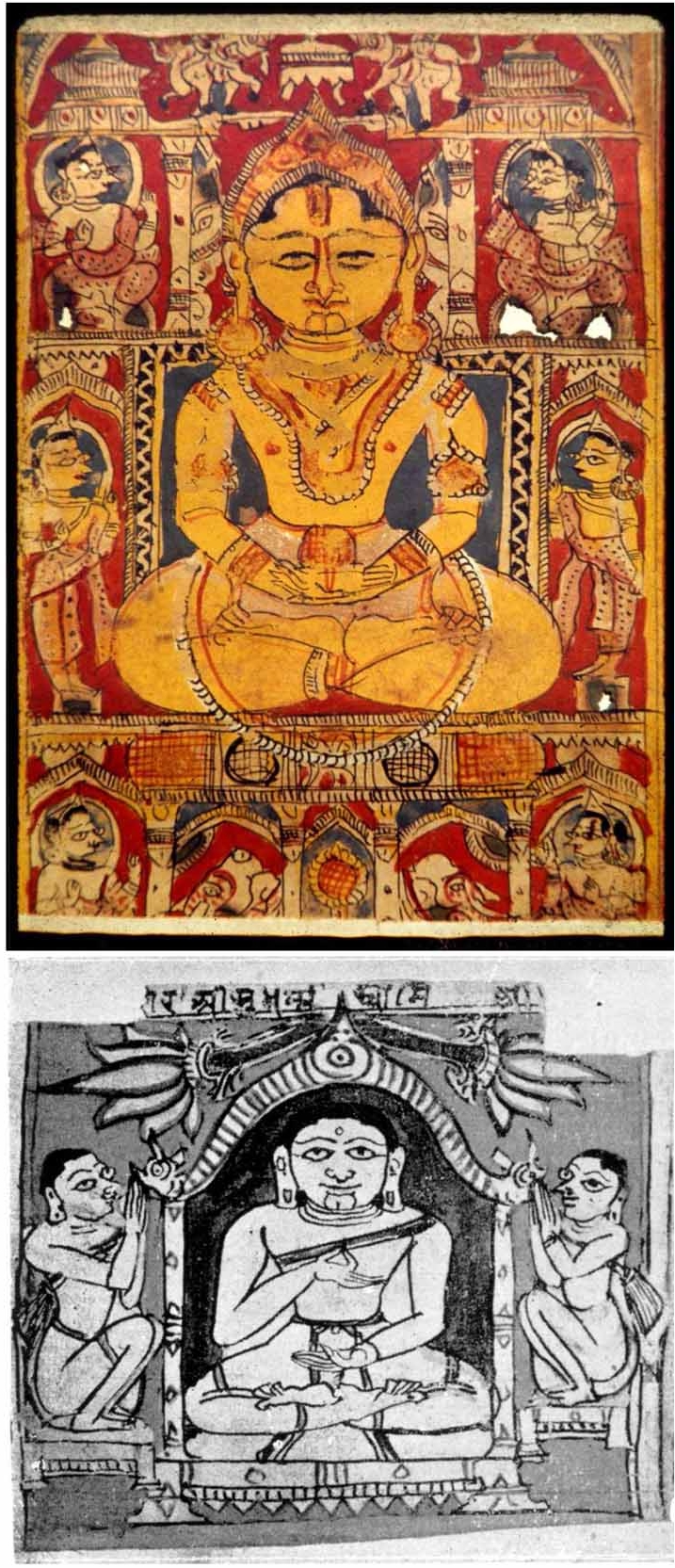
Plate 11.2 & fig.2
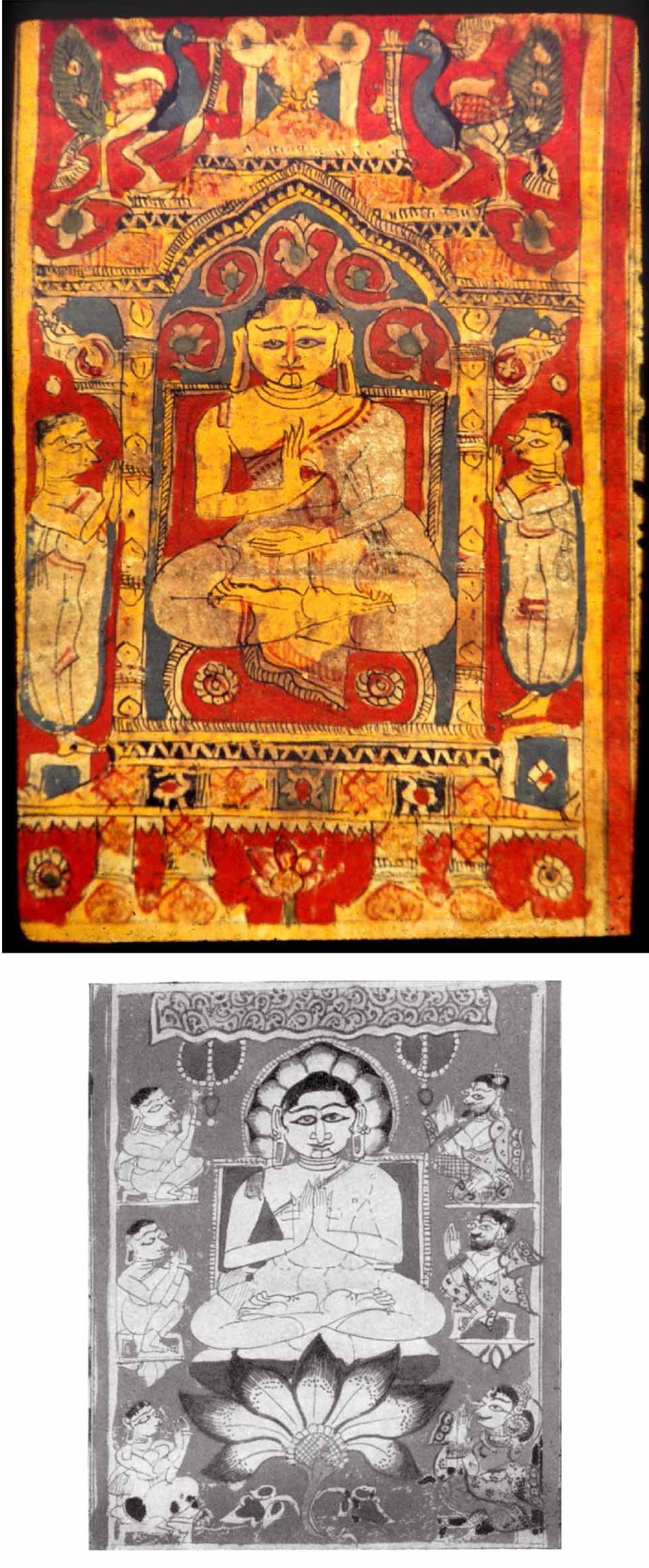
Plate 11.3 & fig.3
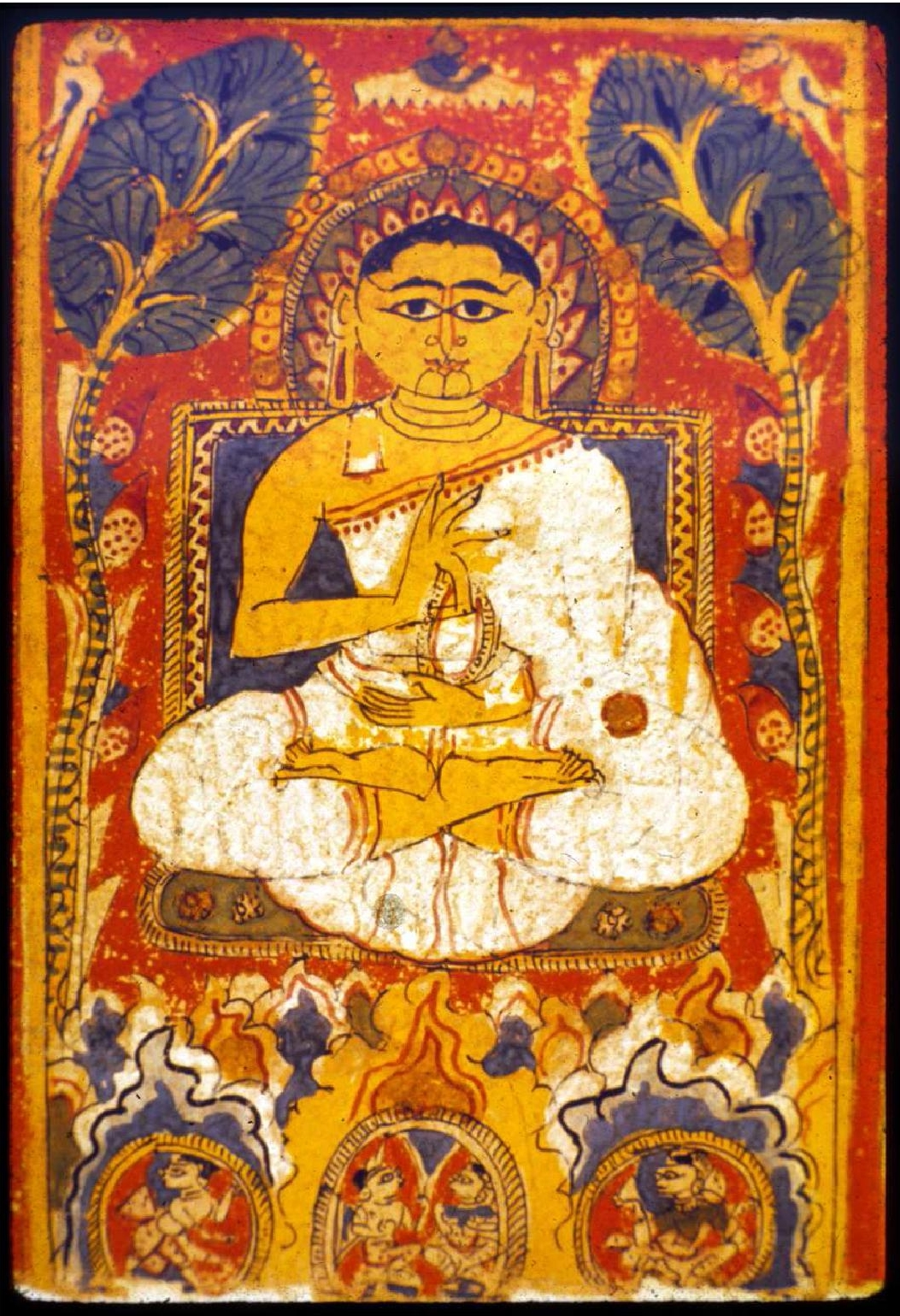
Plate 11.4
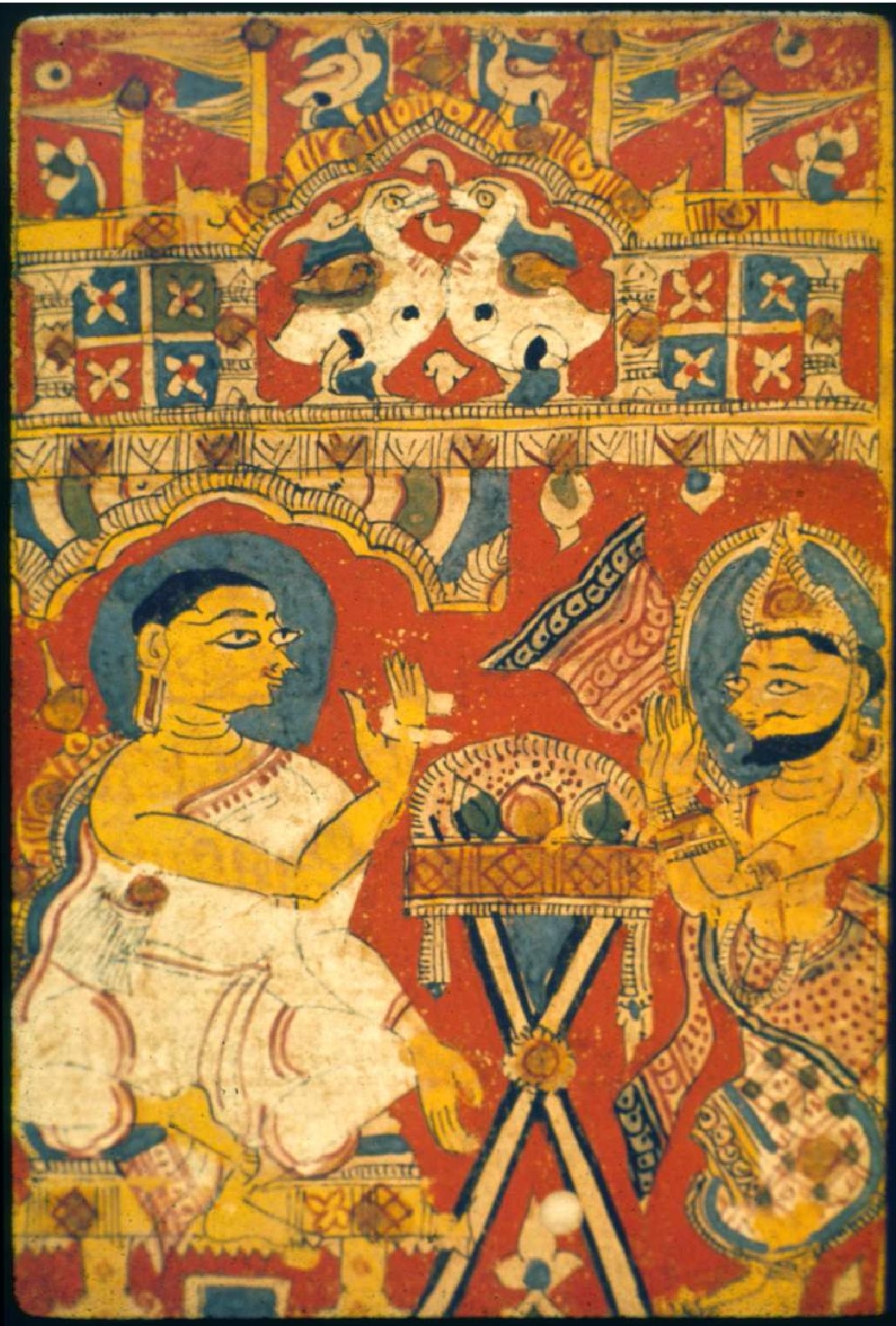
Plate 11.5

Plate 11.6
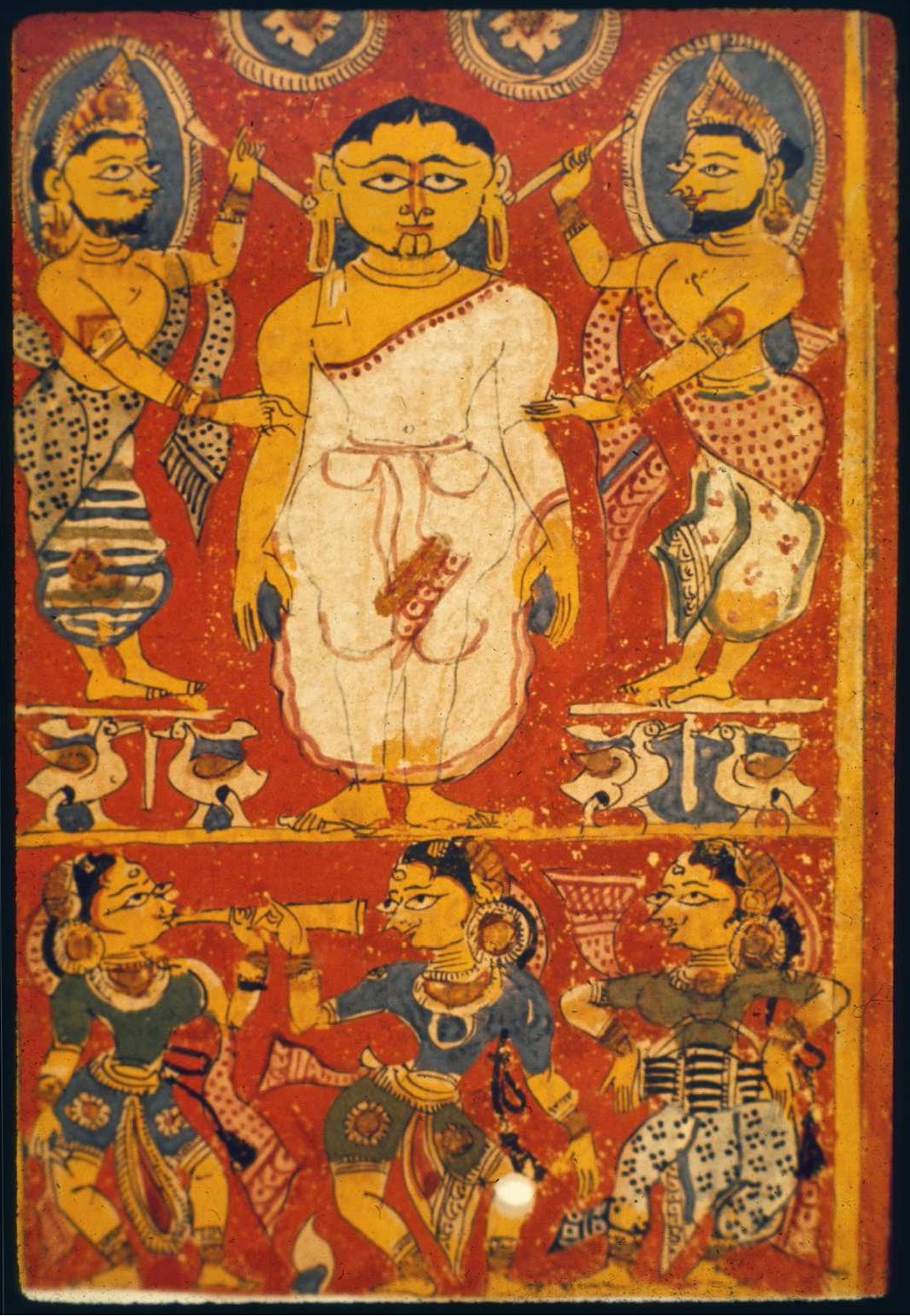
Plate 11.7
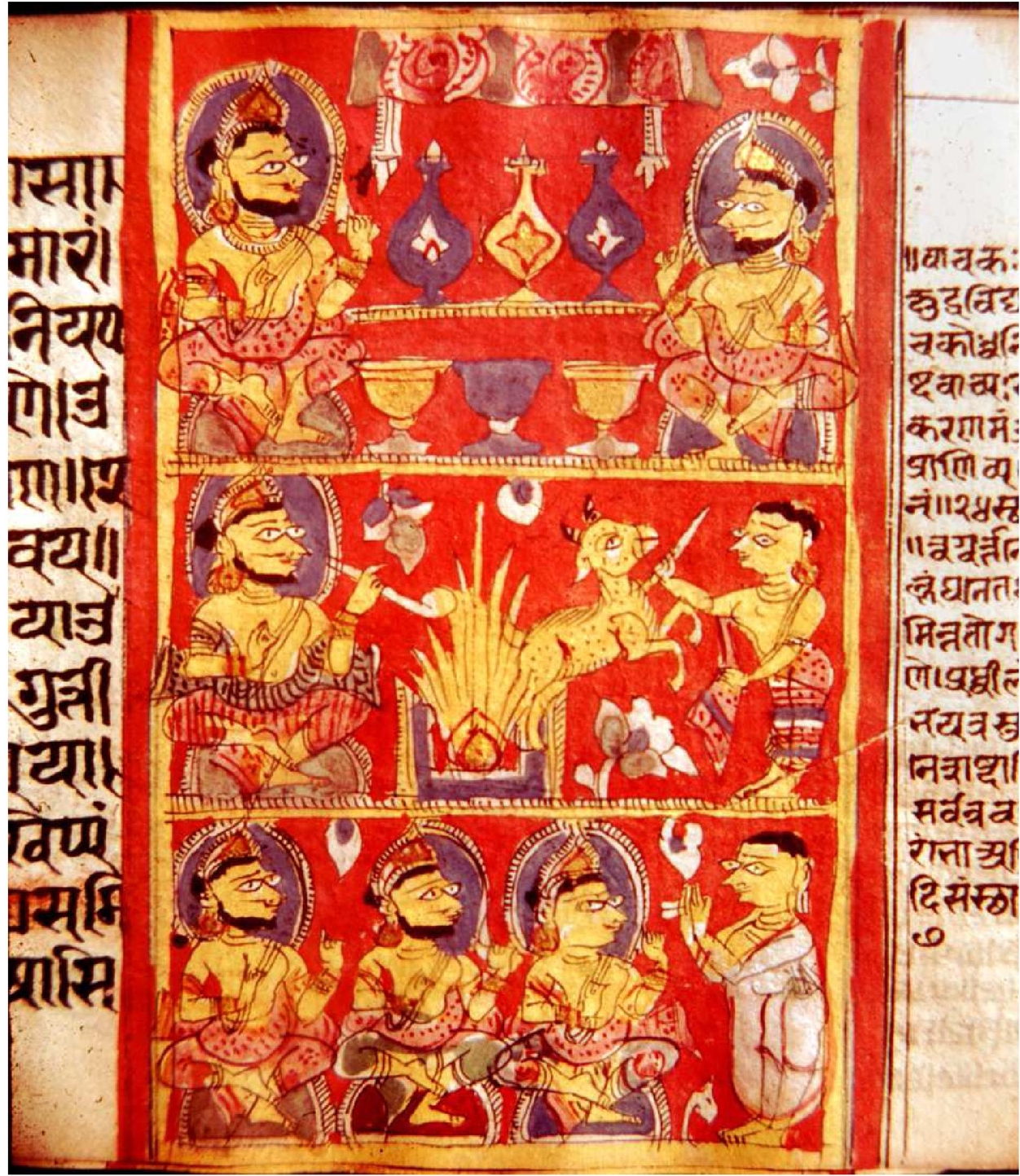
Plate 11.8
 Prof. Dr. Klaus Bruhn
Prof. Dr. Klaus Bruhn

